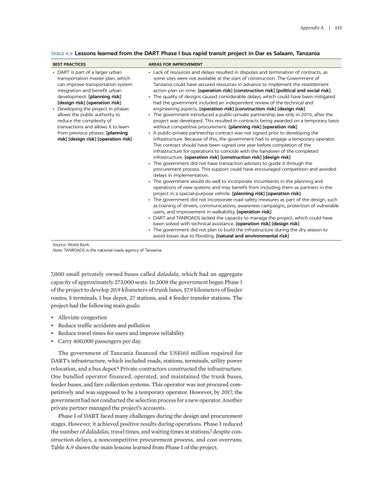Appendix A | 153
TABLE A.9 Lessons
learned from the DART Phase I bus rapid transit project in Dar es Salaam, Tanzania
BEST PRACTICES
AREAS FOR IMPROVEMENT
• DART is part of a larger urban transportation master plan, which can improve transportation system integration and benefit urban development. [planning risk] [design risk] [operation risk] • Developing the project in phases allows the public authority to reduce the complexity of transactions and allows it to learn from previous phases. [planning risk] [design risk] [operation risk]
• Lack of resources and delays resulted in disputes and termination of contracts, as some sites were not available at the start of construction. The Government of Tanzania could have secured resources in advance to implement the resettlement action plan on time. [operation risk] [construction risk] [political and social risk] • The quality of designs caused considerable delays, which could have been mitigated had the government included an independent review of the technical and engineering aspects. [operation risk] [construction risk] [design risk] • The government introduced a public-private partnership law only in 2010, after the project was developed. This resulted in contracts being awarded on a temporary basis without competitive procurement. [planning risk] [operation risk] • A public-private partnership contract was not signed prior to developing the infrastructure. Because of this, the government had to engage a temporary operator. The contract should have been signed one year before completion of the infrastructure for operations to coincide with the handover of the completed infrastructure. [operation risk] [construction risk] [design risk] • The government did not have transaction advisers to guide it through the procurement process. This support could have encouraged competition and avoided delays in implementation. • The government would do well to incorporate incumbents in the planning and operations of new systems and may benefit from including them as partners in the project in a special-purpose vehicle. [planning risk] [operation risk] • The government did not incorporate road safety measures as part of the design, such as training of drivers, communications, awareness campaigns, protection of vulnerable users, and improvement in walkability. [operation risk] • DART and TANROADS lacked the capacity to manage the project, which could have been solved with technical assistance. [operation risk] [design risk] • The government did not plan to build the infrastructure during the dry season to avoid losses due to flooding. [natural and environmental risk]
Source: World Bank. Note: TANROADS is the national roads agency of Tanzania.
7,000 small privately owned buses called daladala, which had an aggregate capacity of approximately 273,000 seats. In 2008 the government began Phase 1 of the project to develop 20.9 kilometers of trunk lanes, 57.9 kilometers of feeder routes, 5 terminals, 1 bus depot, 27 stations, and 4 feeder transfer stations. The project had the following main goals: • • • •
Alleviate congestion Reduce traffic accidents and pollution Reduce travel times for users and improve reliability Carry 400,000 passengers per day.
The government of Tanzania financed the US$165 million required for DART’s infrastructure, which included roads, stations, terminals, utility power relocation, and a bus depot.6 Private contractors constructed the infrastructure. One bundled operator financed, operated, and maintained the trunk buses, feeder buses, and fare collection systems. This operator was not procured competitively and was supposed to be a temporary operator. However, by 2017, the government had not conducted the selection process for a new operator. Another private partner managed the project’s accounts. Phase I of DART faced many challenges during the design and procurement stages. However, it achieved positive results during operations. Phase I reduced the number of daladalas, travel times, and waiting times at stations,7 despite construction delays, a noncompetitive procurement process, and cost overruns. Table A.9 shows the main lessons learned from Phase I of the project.

